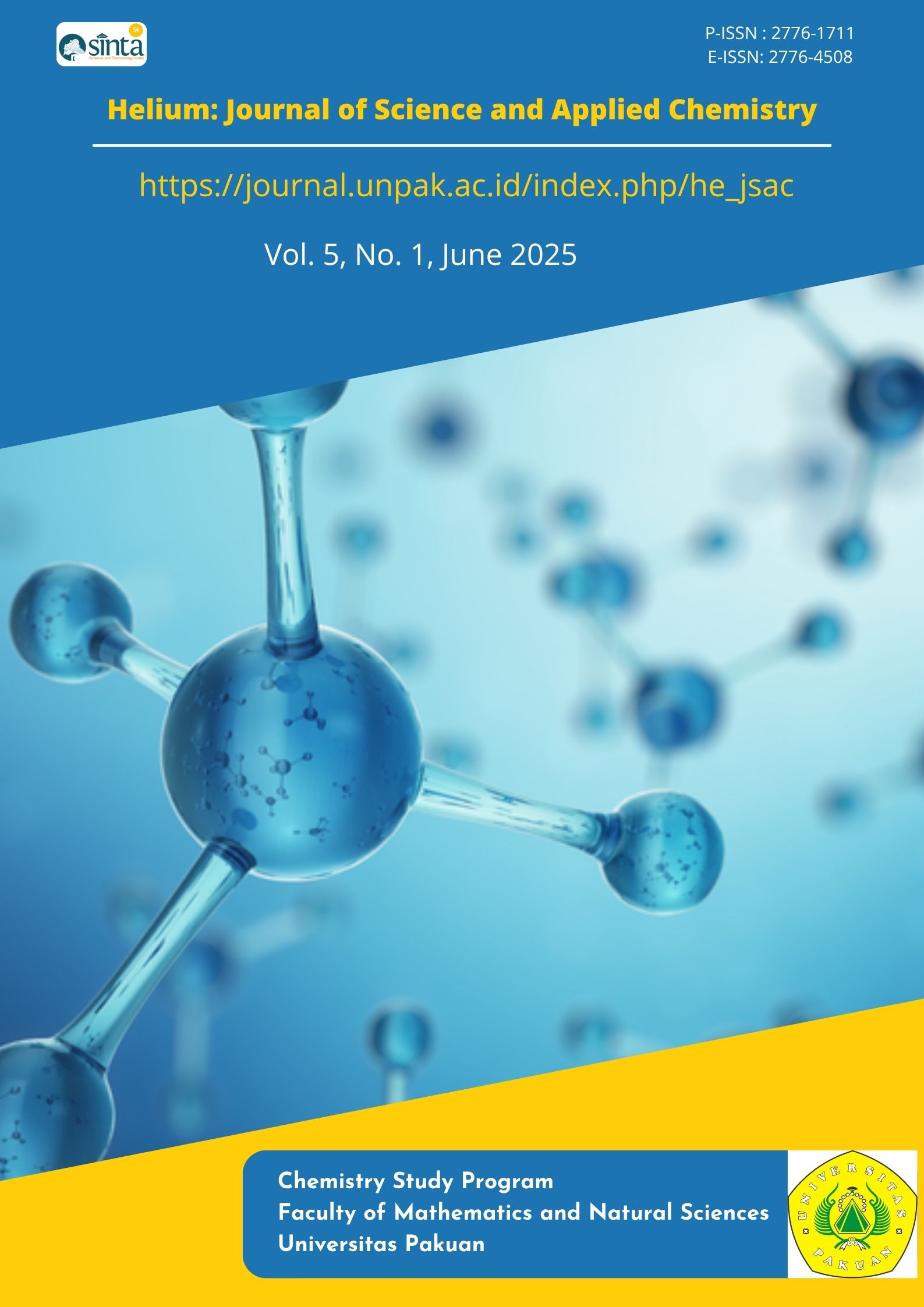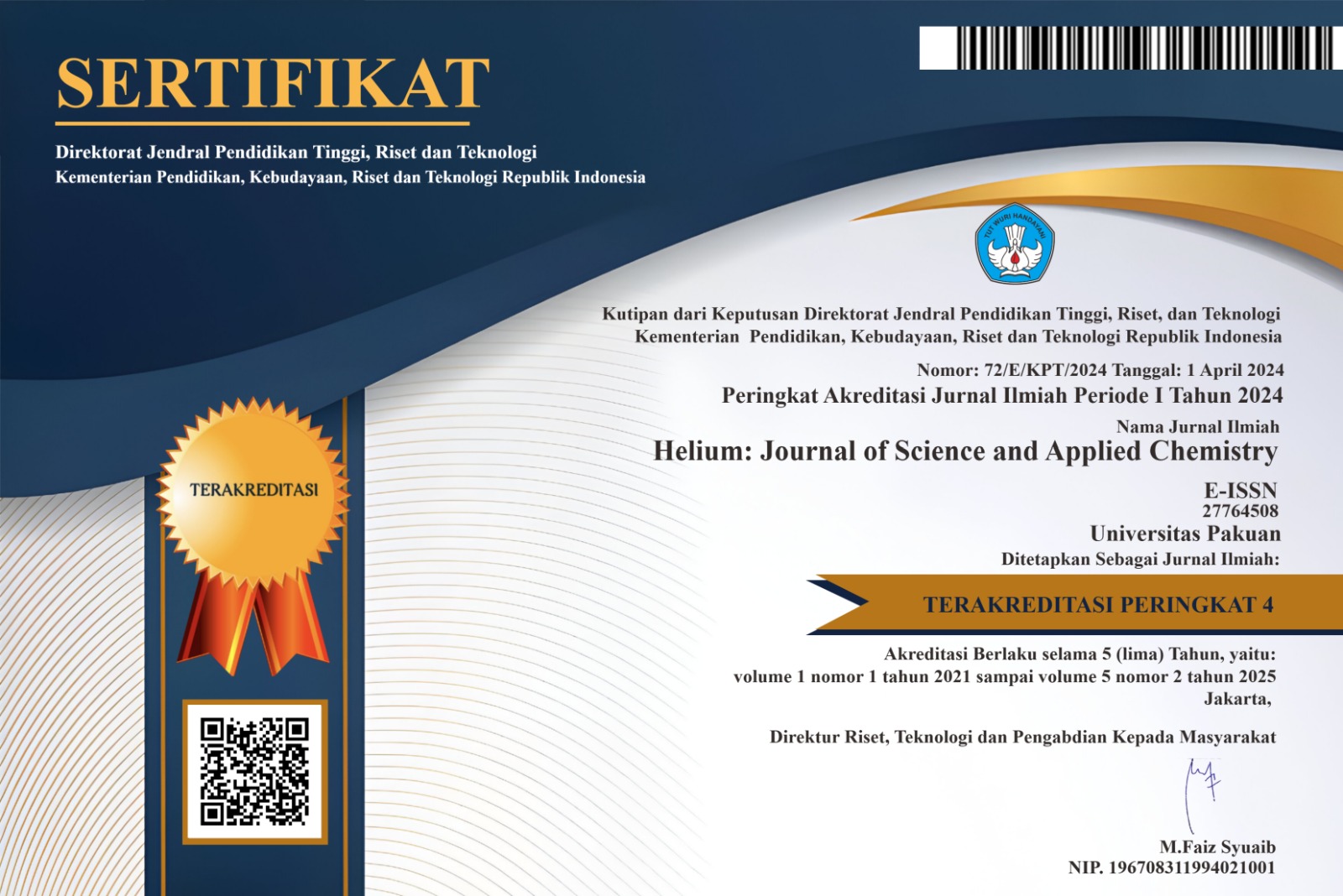Combination of Coagulation and Fermentation Technology in Utilizing Liquid Tofu Waste into Liquid Organic Fertilizer for the Growth of Chinese Spinach (Amaranthus dubius) Plants
DOI:
https://doi.org/10.33751/helium.v5i1.20Keywords:
Effective Microorganisms, Fermentation, Coagulation, Waste Liquid TofuAbstract
Wastewater is known to contain organic compounds, such as proteins, fats, and carbohydrates, which can be utilized more effectively through technology, coagulation, and fermentation, allowing it to be used as an organic liquid fertilizer (OLF), a more environmentally friendly option. Research objectives are to determine the influence of powder seed sour Java as a coagulant on lower COD and BOD levels, the effect of adding EM4 to nutrients in waste liquid, and the impact of POC on the growth of spinach China (Amaranthus dubius). This research is conducted through the process of coagulation and flocculation using a solution seed powder of sour Java with varying concentrations of 500, 1000, 1500, 2000, and 2500 ppm. The concentration of 1500 ppm has resulted in the lowest COD and BOD levels, respectively, 250 ppm and 127 ppm. The solution with the lowest COD and BOD levels is fermented using EM4 with variations of 0, 0.5, 1, 1.5, and 2mL. The addition of EM4 is expected to accelerate the fermentation process and enhance the availability of beneficial nutrients, including N, P, and K, for plant growth and development. The total content of N, P, and K is highest, at 2.087%, following the addition of 1 mL of EM4 to 150 mL of the sample. POC with the addition of 1 mL of EM4 was applied to the spinach plant in China, resulting in a plant 25 cm tall, with nine leaves, and a total fresh weight of 39 grams.
References
S. Nurhasanah, D. Wulandari, and A. Wahyudi, “The effect of aeration process on the reduction of BOD and COD in tofu wastewater,” J. Environ. Eng., vol. 27, no. 2, pp. 87–93, 2021.
P. T. Nguyen, H. H. Ngo, W. Guo, and L. D. Nghiem, “Treatment of high-strength wastewater from tofu production by anaerobic membrane bioreactor,” Bioresour. Technol., vol. 282, pp. 368–374, 2019, doi: 10.1016/j.biortech.2019.02.047.
Y. Astuti and A. S. Prasetyo, “Utilization of tofu wastewater into liquid organic fertilizer through fermentation process,” J. Indones. Agric. Sci., vol. 25, no. 1, pp. 14–21, 2020.
S. B. Kurniawan, M. F. Imron, and A. Iskandar, “Recent advancements in the application of coagulation–flocculation process for industrial wastewater treatment,” Environ. Technol. Innov., vol. 25, 102020, 2022, doi: 10.1016/j.eti.2021.102020.
FAO, The State of the World's Land and Water Resources for Food and Agriculture – Systems at Breaking Point, Rome: Food and Agriculture Organization of the United Nations, 2021.
J. Chen, “The combined use of chemical and organic fertilizers and/or biofertilizer for crop growth and soil fertility,” in Proc. Int. Workshop Sustained Management Soil-Rhizosphere System, 2006, pp. 16–20.
O. V. Kharissova, B. I. Kharisov, and C. M. Oliva González, “Green and sustainable agriculture: Use of natural fertilizers and biofertilizers,” Chemosphere, vol. 285, 131398, 2021, doi: 10.1016/j.chemosphere.2021.131398.
A. Sutanto, B. H. Prasetyo, and A. Hidayat, “Effect of organic fertilizer on physical and chemical properties of soil and corn yield,” J. Soil Land Resour., vol. 7, no. 2, pp. 591–600, 2020.
R. M. Dangelico and D. Pujari, “Mainstreaming green product innovation: Why and how companies integrate environmental sustainability,” J. Bus. Ethics, vol. 95, no. 3, pp. 471–486, 2010.
S. R. Dewi and S. Hadi, “Community empowerment in processing organic waste into liquid fertilizer for economic independence,” J. Community Serv., vol. 5, no. 1, pp. 14–21, 2019.
G. T. Metcalf and H. Eddy, Wastewater Engineering: Treatment and Resource Recovery, 5th ed. New York, NY, USA: McGraw-Hill Education, 2014.
D. Lestari and H. Susanto, “Effectiveness of natural and chemical coagulants in reducing tofu wastewater pollutants,” J. Environ. Eng., vol. 27, no. 1, pp. 33–41, 2021.
R. N. Yanti, H. Purnomo, and A. Wahyudi, “Fermentation of tofu liquid waste using baker’s yeast for liquid organic fertilizer production,” J. Agric. Technol., vol. 21, no. 2, pp. 85–93, 2020.
K. Y. Kim, K. B. Lee, and C. O. Jeon, “Microbial communities and metabolic pathways involved in the degradation of organic matter in anaerobic digesters for wastewater treatment,” Sci. Rep.., vol. 8, 1181, 2018, doi: 10.1038/s41598-018-19466-6.
M. Ariani and S. Gunawan, “Processing of small-scale tofu industry liquid waste into liquid organic fertilizer,” J. Technol. Innov., vol. 10, no. 1, pp. 45–52, 2019.
H. Supriyadi and B. E. Prasetyo, “Growth and yield of spinach (Amaranthus spp.) on several planting media types,” J. Hortic., vol. 28, no. 1, pp. 32–38, 2018.
M. Ali and S. C. S. Tsou, “Combating micronutrient deficiencies through vegetables – A neglected food frontier in Asia,” Food Policy, vol. 22, no. 1, pp. 17–38, 1997.
D. P. Sari and S. Rahayu, “Growth response of spinach (Amaranthus sp.) to application of organic and inorganic fertilizers,” J. Trop. Agrotech., vol. 8, no. 1, pp. 45–52, 2020.
G. Pramono and H. Sutikno, “Effect of liquid organic fertilizer from organic waste on growth and yield of red spinach (Amaranthus tricolor),” J. Agrosci., vol. 19, no. 2, pp. 101–107, 2021.
F. Wulandari and S. Yuliani, “Utilization of tofu liquid waste as environmentally friendly liquid organic fertilizer for vegetable crops,” J. Sustain. Environ. and Agric. Management, vol. 6, no. 1, pp. 73–80, 2022.
P. Marschner, Marschner’s Mineral Nutrition of Higher Plants, 3rd ed. London, UK: Academic Press, 2012.
B. H. Purwanto and T. Haryanti, “The role of nitrogen in the growth and yield of horticultural crops,” J. Indonesian Horticult., vol. 9, no. 2, pp. 113–121, 2018.
C. Grant, S. Bittman, M. Montreal, C. Plenchette, and C. Morel, “Soil and fertilizer phosphorus: Effects on plant P supply and mycorrhizal development,” Can. J. Plant Sci., vol. 85, no. 1, pp. 3–14, 2005.
W. T. Pettigrew, “Potassium influences on yield and quality production for maize, wheat, soybean and cotton,” Physiol. Plant., vol. 133, no. 4, pp. 670–681, 2008, doi: 10.1111/j.1399-3054.2008.01073.x.
W. H. Nugroho and B. Prasetyo, “Macronutrient content in liquid organic fertilizer from tofu wastewater and its effect on spinach growth,” J. Agric. Environ. Sci., vol. 12, no. 1, pp. 55–62, 2021.
M. Yuliastri and Sutaryo, “Processing of tofu liquid waste into liquid organic fertilizer using EM4 and anaerobic fermentation,” J. Agric. Technol., vol. 21, no. 1, pp. 12–19, 2020.
A. J. Adi and Z. Z. Noor, “Coagulation–flocculation treatment of wastewater in the petroleum industry using inorganic coagulants: A review,” J. Hazard. Mater., vol. 170, no. 1, pp. 530–541, 2009.
Ministry of Agriculture, Republic of Indonesia, Ministerial Decree No. 261/KPTS/SR.310/M/4/2019 on Organic Fertilizer, Biofertilizer, and Soil Conditioner Standards, Jakarta, Indonesia: Ministry of Agriculture, 2019.
D. Rachmawati and Hadiyanto, “Utilization of tofu liquid waste for production of liquid organic fertilizer with the addition of EM4,” J. Chem. Eng. Indones., vol. 16, no. 2, pp. 45–52, 2017.
APHA, AWWA, and WEF, Standard Methods for the Examination of Water and Wastewater, 23rd ed., Washington, DC: American Public Health Association, 2017.
R. R. Ayangunna, S. O. Giwa, and A. Giwa, “Coagulation Flocculation Treatment of Industrial Wastewater Using Tamarind Seed Powder,” Int. J. ChemTech Res., vol. 9, no. 5, pp. 771–780, 2016.
T. Leksono, R. Banjarnahor, N. Irasari, and S. W. Sidauruk, “Liquid organic fertilizer produced from innards waste of catfish (Pangasius djambal) by using fermentative microbes (EM4) and molasses,” IOP Conf. Ser.: Earth Environ. Sci., vol. 1328, no. 1, p. 012019, 2024, doi: 10.1088/1755-1315/1328/1/012019.
J. Kjeldahl, “Neue Methode zur Bestimmung des Stickstoffs in organischen Körpern,” Z. Anal. Chem., vol. 22, no. 1, pp. 366–383, 1883.
Hach Company, Molybdovanadate Reagent for Phosphorus Determination (Method 8114), Loveland, CO: Hach, 2025.
Hach, “Phosphorus, Total – Molybdovanadate with Acid Persulfate,” application note, 2024. §
M. Fawzy, "Fertilizer Analysis Protocol,” Scribd, 2015. Available: Fertilizer Analysis Protocol.
Hendrawati, “Use of tamarind seeds (Tamarindus indica L.) and winged bean seeds (Psophocarpus tetragonolobus L.) as natural coagulants in groundwater quality improvement,” Valensi, vol. 3, no. 1, pp. 23–34, 2013.
T. J. Galuh and Yusniar, “Effectiveness of alum and tamarind seed powder (Tamarindus indica) in reducing COD levels in laundry wastewater,” Dept. Public Health, Diponegoro Univ., Semarang, Indonesia, 2015.
Ministry of Environment of the Republic of Indonesia, “Regulation No. 5 of 2014 on Wastewater Quality Standards,” Jakarta, Indonesia, 2014.
A. A. Ndabigengesere and K. S. Narasiah, “Quality of water treated by coagulation using Moringa oleifera seeds,” Water Research, vol. 32, no. 3, pp. 781–791, Mar. 1998, doi: 10.1016/S0043-1354(97)00295-9.
M. R. Teh, P. Wu, and P. Juan, “Optimal coagulant dosing for turbidity removal: Restabilization and charge reversal phenomena,” Journal of Environmental Management, vol. 206, pp. 1004–1011, Jan. 2018, doi: 10.1016/j.jenvman.2017.11.009.
M. A. Beltrán-Heredia and J. Sánchez-Martín, “Treatment of wastewater by Moringa oleifera extract: a review,” Environmental Technology Reviews, vol. 3, no. 1, pp. 82–93, 2014, doi: 10.1080/21622515.2014.980011.
S. M. P. Marendra et al., “Lab scale investigation on biocoagulant performance to remove organic from tempe liquid waste treatment,” IOP Conf. Ser.: Earth Environ. Sci., vol. 1381, p. 012038, 2024.
P. Pujiastuti, Y. M. Wibowo, and N. Narimo, “The biocoagulation test of tamarind seed (Tamarindus indica) and winged bean in chemical laboratory wastewater,” AIP Conf. Proc., vol. 2638, p. 100002, 2022.
Reski, “Training on the production of organic fertilizer from agricultural and household organic waste in Batulaya Village, Tinambung Regency, West Sulawesi,” Agr. Technol. Educ., State Univ. of Makassar, 2023.
M. Ronga, G. Parisi, L. Pentangelo, et al., “Effective microorganisms (EM) improve compost quality, microbial activity and lettuce yield,” Agronomy for Sustainable Development, vol. 38, no. 2, pp. 1–10, 2018, doi: 10.1007/s13593-018-0502-3.
M. Ronga, A. Parisi, G. Ilaria, et al., “Effect of microbial inoculants on tomato (Solanum lycopersicum L.) under organic farming conditions,” Agronomy, vol. 9, no. 3, pp. 1–14, Mar. 2019, doi: 10.3390/agronomy9030143.
S. Saha, R. Prakash, and R. D. Singh, “Biofertilizers: A potential tool for sustainable agriculture,” Environmental Technology & Innovation, vol. 23, p. 101603, 2021, doi: 10.1016/j.eti.2021.101603.
M. R. Glick, “Plant growth-promoting bacteria: mechanisms and applications,” Scientifica, vol. 2012, Article ID 963401, pp. 1–15, 2012, doi: 10.6064/2012/963401.
R. Arif, I. Ali, and H. Fauziyah, “Effect of watering intervals on the growth and development of spinach (Amaranthus spinosus),” J. Biol. Sci., vol. 5, no. 2, pp. 123–130, 2017.
T. R. Whiteley, R. J. Read, and M. R. Tredgett, “Over-inoculation effects in microbial fermentation systems,” Journal of Applied Microbiology, vol. 121, no. 3, pp. 603–612, Sep. 2016, doi: 10.1111/jam.13199.
J. C. van Zijderveld, J. Dijkstra, W. van Straalen, H. B. Perdok, and J. van Vuuren, “Effect of microbial inoculant levels on nitrogen efficiency in fermentative processes,” Animal Feed Science and Technology, vol. 145, no. 1-4, pp. 102–117, Feb. 2008, doi: 10.1016/j.anifeedsci.2007.07.002.
E. M. Jackson and C. L. Carter, “Effect of EM application on nutrient cycling and losses during compost fermentation,” Bioresource Technology, vol. 124, pp. 287–292, Dec. 2012, doi: 10.1016/j.biortech.2012.08.011.
N. R. Yuliani, A. R. Purnama, and S. Wahyuni, "The Effect of EM4 on Nutrient Availability and Growth of Organic Vegetables," International Journal of Agricultural Research, vol. 15, no. 4, pp. 176–183, 2021, doi: 10.3923/ijar. 2021.176.183.
R. Seneviratne, L. Indrasena, and K. Jayasinghearachchi, "Effective Microorganisms (EM) in organic agriculture: a review of past research," Journal of Agricultural Sciences, vol. 5, no. 1, pp. 1–8, 2010.
Y. Zhang, J. Liu, X. Wang, and W. Zhao, "Microbial balance and phytotoxic risk during fermentation of organic fertilizer with EM," Bioresource Technology, vol. 234, pp. 160–167, 2017, doi: 10.1016/j.biortech.2017.03.061
Downloads
Published
How to Cite
Issue
Section
License
Copyright (c) 2025 Helium: Journal of Science and Applied Chemistry

This work is licensed under a Creative Commons Attribution-NonCommercial-ShareAlike 4.0 International License.













